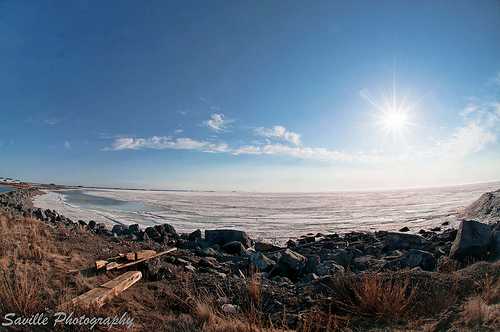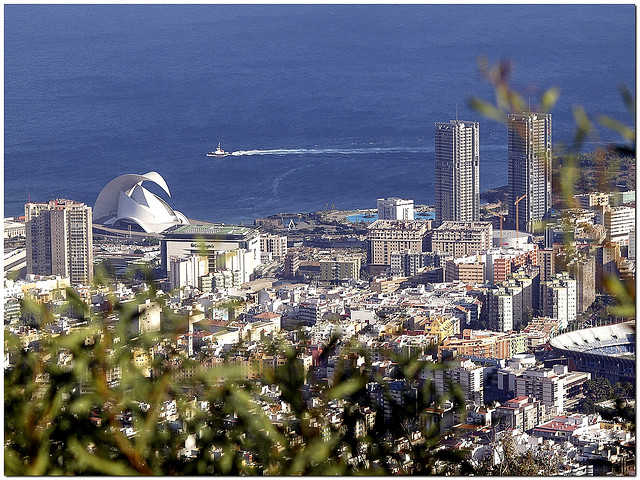Environment
Greenpeace versus Gazprom in the Arctic Region
Have you ever seen a boxing match? Usually every contact sport is a bloody one. Foreign affairs and diplomacy can be placed under the umbrella of contact sports. Every day we hear about huge geopolitical battles between corporations, governments, NGOs and individuals from all over the world. So, in the red corner we have Gazprom, a huge Russian state-owned corporation and in the blue corner we have Greenpeace. According to their website, Greenpeace is an independent campaigning organisation which uses non-violent, creative confrontation to expose global environmental problems and to force the solutions which are essential to a green and peaceful future.
In order to understand the nature of this conflict we need to answer to the following question: why did Greenpeace decide to target Gazprom Prirazlomnaya oil platform? The Arctic region is very rich in natural resources. According to Ernst&Young, this region accounts for 20% of the undiscovered and recoverable oil and natural gas resources. According to a document from the United States Geological Survey in the entire region there are more than 90 billion barrels of oil and 1.6 trillion cubic feet of natural gas.
Prirazlomnaya oil platform is going to extract oil from the Arctic region. This is a harsh environment and an oil spill could be catastrophic for the entire area. In tropical and, generally speaking, in warmer waters, the impact of an oil spill is mitigated by small organisms which absorb the oil, but in the Arctic region this process is not possible. 24 years ago, there was an oil spill near Alaska known as Exxon Valdez accident. Even today the environment is still damaged by that terrible moment.
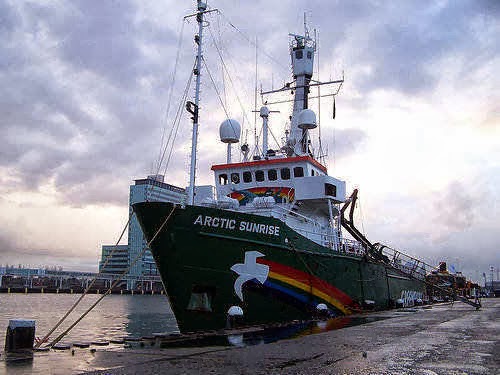
Image by: Bert Kommerij
Greenpeace decided to target the oil platform because the risks are too high for the environment. The Prirazlomnaya oil field contains 70 million tons of oil reserves and the production per year is estimated around 6.6 million tons. The Prirazlomnaya oil platform is a massive facility and according Gazprom it can resist even a torpedo strike.
On 18th September, the Arctic Sunrise (one of Greenpeace ships) was involved in a protest at Gazprom’s oil platform which is the first to produce oil from ice filled Arctic seas. There were 28 activists and one freelance videographer and one freelance photographer involved in this protest. They were detained by the FSB (Russian Federal Service) and charged with piracy. From the international criminal law perspective and even from the Russian penal code the Russian coast guard was not entitled to board the Arctic Sunrise in international waters. One week later, Vladimir Putin says that ”Greenpeace activists are not obviously pirates.”
On 27th September a Russian court ordered that 22 activists will be held in custody for 3 months and the rest of them for 3 days and after that, the Russian court decided to held in custody the entire crew for a longer period of time. All of them were officially charged with piracy at the beginning of October. They face a maximum 15 year prison sentence.
Thousands of people from 48 countries engaged in a huge solidarity movement called Free The Arctic 30. More than 1 million of support letters were sent to Russian embassies around the world. Governments and teachers reacted and condemned the behavior and the unsubstantiated allegations of piracy. Recently, the Russian committee investigating the Arctic Sunrise and the activists said that they discovered narcotic substances, like morphine, among the confiscated items from the Arctic Sunrise. Now the allegations can be modified.(Russia Today) Serghei Lavrov, Russia’s foreign minister said that third parties should not interfere between Russia and Greenpeace. This is a not a reasonable request because there are 18 nationalities among the 30 activists.
The control over the Arctic waters is very important for Russia. Arctic territory is and will be disputed by Canada, Russia, Greenland and the US, but we must have in mind that this area is very rich in natural resources. Russia reopened an old military base and 30 ships were deployed around the region including a nuclear cruiser. At the end of the day we can say that the confrontation between Greenpeace and Russia is another geopolitical battle for the future, for the control of the Arctic waters and land. The judicial system in Russia has a bad reputation and there are many examples from the past: the protest group Pussy Riot or the fallen oligarch Khodorkovsky. Artur Akopov a senior official from Gazprom said that the actions of the Arctic Sunrise crew could have threatened the environment and the oil platform – the same oil platform that can withstand a torpedo strike.
One can’t help but wonder how this confrontation will end and which instruments can be used to put some pressure on the Russian government or even on Gazprom in order not to over-step their boundaries. And is it right for a Russian court decide the fate of the activists by itself? We’ll just have to wait and see.
Environment
The Future of Fashion: The Rise of Eco-Conscious Brands in the Luxury Market
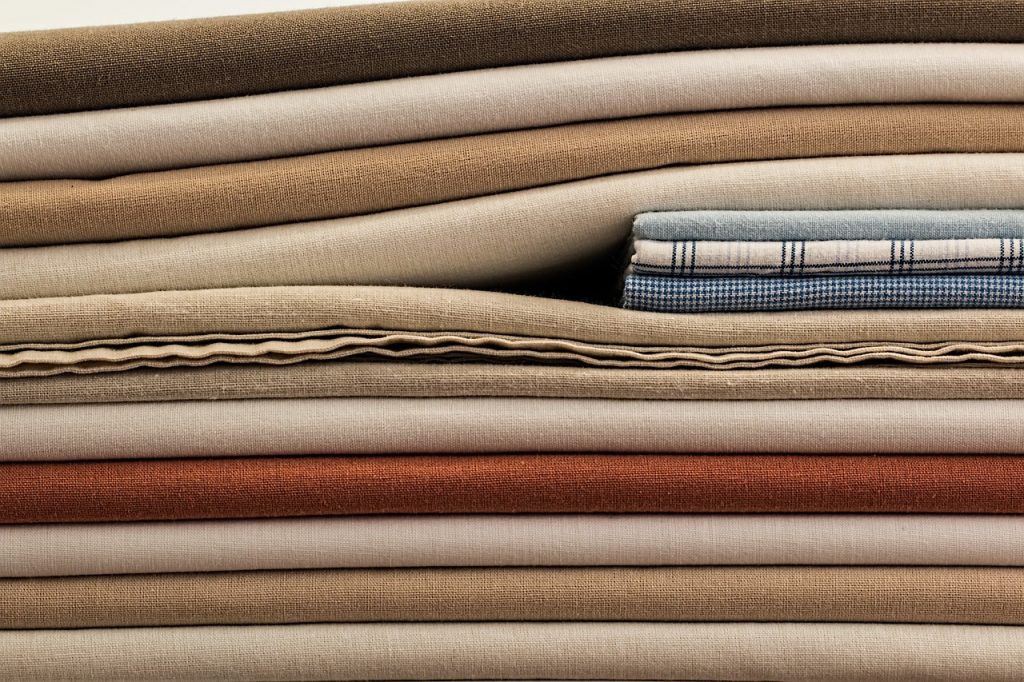
The once opulent and exclusive realm of luxury fashion is undergoing a dramatic transformation. Driven by a growing global consciousness about environmental impact, consumers are demanding more sustainable choices, even at the highest price points. This shift in consumer preferences is reshaping the industry, forcing luxury brands to reevaluate their production processes and material sourcing.
As a result, luxury eco-friendly collections are becoming increasingly sought after, and brands that prioritize sustainability are gaining a competitive edge.
Key Trends Shaping the Market
The luxury fashion market is experiencing a significant shift as sustainability becomes a core value for both brands and consumers. One of the most prominent trends is the rise of eco-friendly fashion that blend high-end design with ethical practices.
These collections are characterized by the use of sustainable materials, such as organic cotton, recycled fabrics, and innovative alternatives to traditional textiles. Brands are also focusing on reducing their environmental impact by adopting eco-friendly production methods, including water-saving technologies and carbon-neutral manufacturing processes.
Brands like Onibai are at the forefront of this movement, offering exquisite designs that not only cater to the aesthetic tastes of discerning customers, but also align with their values of sustainability. As consumers become more aware of the environmental and social implications of their purchases, they are increasingly seeking out brands that offer a blend of luxury and responsibility.
Consumer Demand Driving the Change
Consumer preferences are increasingly dictating the trajectory of the fashion industry. A growing emphasis on sustainability and ethical practices has empowered consumers to demand more from the brands they support. This shift in consumer behavior has led to a surge in demand for luxury eco-friendly products, forcing fashion houses to adapt their business models accordingly. This demand for transparency and ethical practices has compelled luxury brands to rethink their strategies and adopt more sustainable business models.
For example, a recent study by McKinsey & Company found that 66 % of global consumers are willing to pay more for sustainable products. This trend is particularly strong among millennials and Gen Z consumers, who are more likely to be environmentally conscious.
Leading the Way: Eco-Conscious Luxury Brands
Several luxury brands have emerged as leaders in the sustainable fashion movement, setting a precedent for the industry. Onibai, for instance, has distinguished itself with its commitment to sustainability, offering luxury eco-friendly collections that resonate with environmentally conscious consumers.
By prioritizing the use of organic materials, low-impact dyes, and fair labor practices, Onibai exemplifies how luxury can coexist with ethical responsibility.
The Future of Luxury Fashion
The rise of eco-conscious brands in the luxury market marks a significant turning point for the fashion industry. As more brands embrace sustainability, the definition of luxury is evolving to encompass not only quality and craftsmanship but also ethical responsibility. This shift is not just a passing trend; it represents the future of fashion, where consumers and brands alike recognize the importance of preserving our planet while enjoying the finer things in life.
In this new era of luxury fashion, eco-friendly collections like those offered by Onibai are leading the way, proving that sustainability is not a compromise but a new standard of excellence. As the demand for sustainable fashion continues to grow, the future of luxury will undoubtedly be defined by its commitment to eco-consciousness, ensuring that elegance and ethics go hand in hand.
Environment
Redefining marine recycling through painting and sculpture
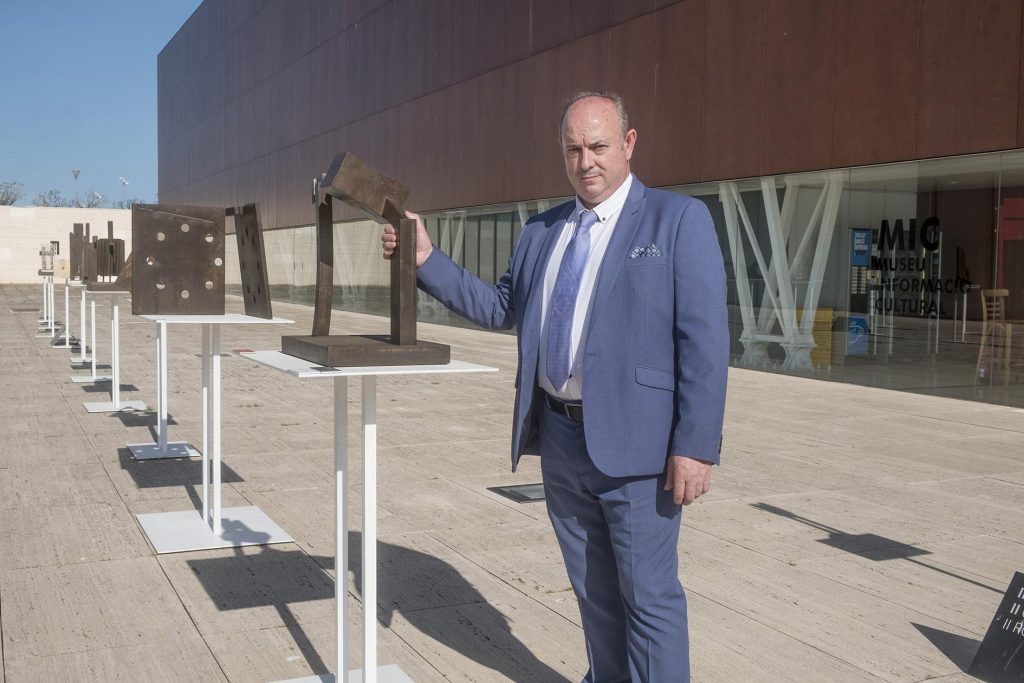
Frutos María Martínez, a self-taught visual artist, has been rescuing waste from the ocean’s waters for decades, turning it into beautiful and elegant artwork. Finishing his first painting and sculpture pieces at just fourteen, Frutos has spent his entire life guided by his passion for art. Becoming a professional artist in the mid-1980s after working at car dealerships, Frutos used his skills and expertise with metal to create sculptures and paintings, inspired by the materials he found along the Mediterranean Coast.
In his pieces, Frutos combines numerous medias to create sculptures, paintings, and collages. As part of his process, María spends time exploring the beaches and waters of Alicante, a Mediterranean city along the southeastern coast of Spain and his home since 1985.
Here, he has found all sorts of materials that have gone on to become pieces in his collections. Steel, iron, wood, nets, and textiles, among other objects, that Frutos salvaged from the ocean can all be found in his art.
By reusing and recycling these found objects, the artist is able to give new life to abandoned and forgotten waste. María recognizes the environmental issues we are facing at a global level, and his art seeks to raise awareness of these challenges. As his materials are pulled straight from the Mediterranean Sea, he is especially invested in taking care of marine life and our oceans. With each item the artist salvages from the ocean, one less piece of waste is polluting the waters.
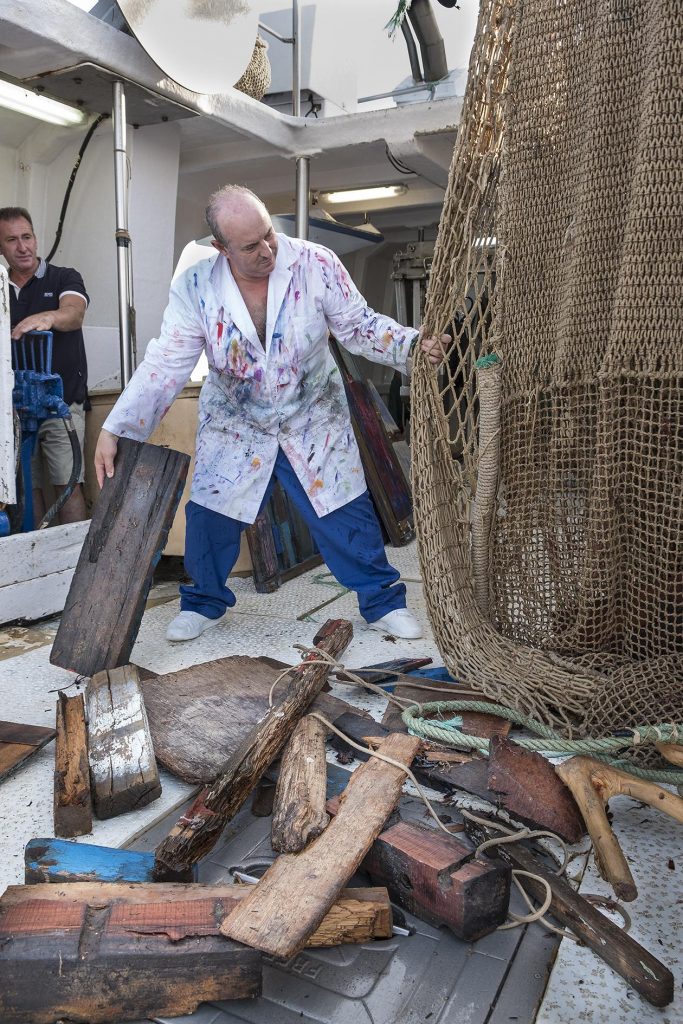
Once the flotsam is collected, Frutos returns to his workshop where he creates works of art in different forms. While other artists may send their work to be fabricated by others, María could not imagine his pieces being created in a place other than his studio. Here, he uses his innate skills with metal and machinery to forge and construct works of beauty. His sculptures follow hard lines, both straight and curved, and his paintings exude color. When making his collages, he takes his found mixed media and creates new stories. He adds paint to wood that was floating in the sea or combines various materials together, reimagining a life for objects that were once trash.
With a true passion for his work, he creates through intuition. He explains that there is a moment when his art becomes completely emotional and personal, “each piece is imbued with my experiences and emotion, all lumped together, all conveyed by means of materials, technique, design and imagination.” The works his hands awaken and renew are the convergence of his mastery and his spirit, bringing new life to discarded objects.These fascinating pieces have been shown in numerous exhibitions, most recently at the Museum of the University of Alicante. There, the artist presented Acero y pecios del mar (Steel and Sea Wrecks), where two collections were displayed jointly, one offering sculptures focused on steel as a material and the other called Nueva Vida, or New Life, a collection whose pieces were created by recycling materials salvaged from sea wreckage. With this collection, he introduced a new layer into his work, adding an element of chaos and destruction to the backstories of his materials.
An earlier exhibition, Janus, displayed over 40 of Frutos’ sculptures on the University of Alicante’s campus. This exhibit, named for the Roman god of doors, gates and transitions, was influenced by the duality of life, of beginnings and ends, and of old and new. While his finished pieces reflect this duality, the materials used to create them manifest this theme through their first death being revived into new life, a tangible and concrete example of the contrasting polarity he was inspired by.
As with his sculpture-centered exhibitions, his shows highlighting his paintings are full of found materials. Pieces that Frutos creates hang with the weight of rescued and recycled materials, such as rusty iron, steel, and wood. This media has been taken from the ocean and included in his art, conjoining with resin, sands, and paint in bold and striking colors.
Frutos María’s ability to not only find new meaning in recycled and salvaged objects, but to clean up the oceans and make the environment less polluted, translate through his moving pieces of artwork, and because of this, he has made a name for himself in the art world.
Environment
Wind energy, the best way to invest into renewable energies
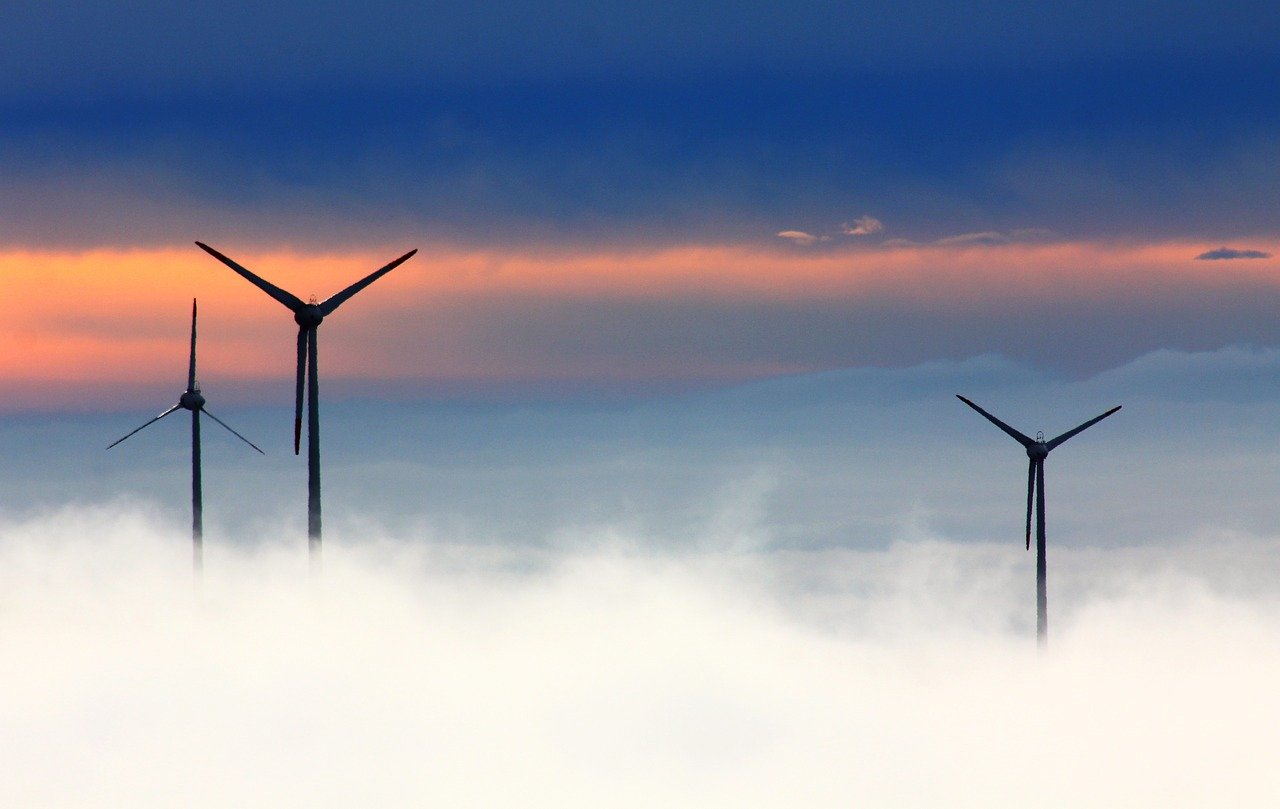
Over the last few years, wind energy has become the type of energy everyone can not stop talking about. This type of energy brings lots of benefits into the table when compared to more traditional sources of energy, like the energy proceeding from radiation or charcoal. Wind energy is cheap to produce, the most efficient renewable energy, and, most importantly, it is an ecological sensitive alternative.
Why should you invest in wind energy?
Wind energy is the energy of tomorrow. This type of energy made their big appearance during the XX century, when wind turbines would be used to bring energy to areas located far from the electricity grid, such as isolated farms, houses or factories.
During the XXI century, wind energy’s popularity kept on rising. Wind energy is as cheap to produce as traditional sources of energy, like radiation or charcoal burning, while falling into the category of renewable energies. This made wind energy become a top contender in the energy industry.
The wind industry’s future looks to be brighter than ever. The current generation is pretty aware of pollution and the effect it has on climate change. This has caused that governments all around the world start promoting new legislations and campaigns promoting renewable energy and, since wind energy is the most efficient type of renewable energy, it is expected that it will become the main source of energy by 2030. Now is the best moment to jump into the wind energy trend!
Making sure you set up an efficient wind farm
As it has been previously stated, wind energy is definitely an option you should consider if you are looking to power up any of your properties or business. However, setting up a wind farm isn’t a small investment, therefore, before starting this process we need to gather all the information we can about its viability. That is why we can not stop recommending that you consult with professional companies like Vortex FDC.
Vortex FDC is a company that has made a name for itself in the wind industry sector. Vortex assists their customers with all the information regarding wind resource they could need.
For example, an important factor we need to consider before setting our wind farm is the terrain. Not all terrains are appropriate to locate a wind farm, therefore, the terrain would need to be assessed before an installation that could result in a waste of assets if the terrain is not appropriate for it. Vortex FDC helps their customers evaluate where the wind farm is going to be placed, and providing information about the wind to choose the type of turbines that would yield better results in that area. Factors like the type of wind (extreme winds, turbulences, etc) or the temperature need to be taken into account when deciding which type of turbine would be more suitable for our wind farm. For example, if we plan to build a wind farm in an area that gets freezing and snowy in winter, we would need to get a turbine system that is cold resistant.
Vortex FDC runs a numerical weather model to feature all the variables that could affect the production levels of your wind farm, regardless of it being situated off-shore or in-shore. Thanks to their always up-to-date technology, you will be able to avoid unpleasant surprises regarding the energy production of your wind farm.
Overall, opting to use wind energy is an amazing idea that will benefit not only our budget, but also the planet. But, in order to do so, we need to make sure that wind farms are viable, and for that, we need to rely on professionals like Vortex FDC.
-
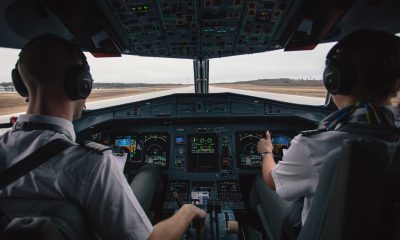
 Technology12 months ago
Technology12 months agoHow Virtual Fly Elevates the World of Flight Simulators
-
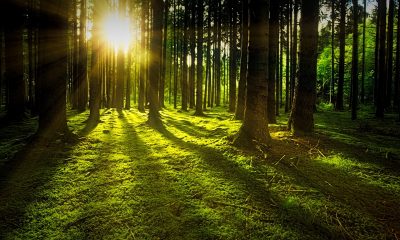
 Travel12 months ago
Travel12 months agoImmerse Yourself in Nature: Explore Forest Bathing with a New Guidebook
-
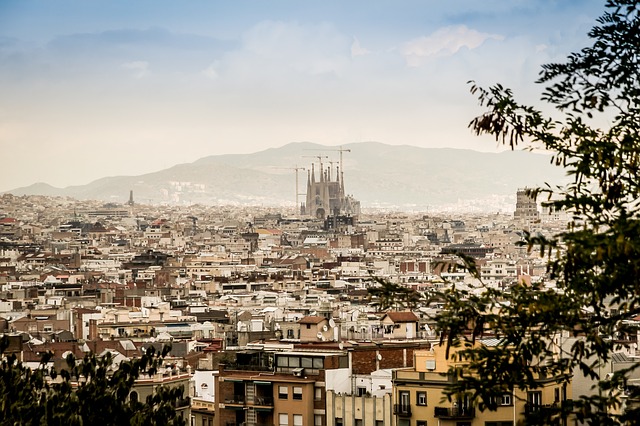
 Europe12 months ago
Europe12 months agoBarcelona and Athens: cities that will leave an everlasting impression
-

 Health12 months ago
Health12 months agoExperience in clinical quality: What is it, and why is it important?
-
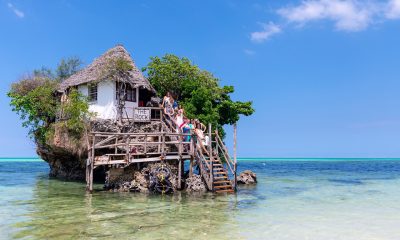
 Travel9 months ago
Travel9 months agoEnjoy a luxury holiday in Zanzibar
-

 Culture and Lifestyle8 months ago
Culture and Lifestyle8 months agoDo you want to surprise a special someone?
-

 Business8 months ago
Business8 months agoServiceNow Development Consultancy: Business Process Automation as Disruptive Technology
-
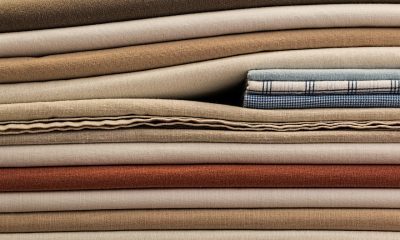
 Environment8 months ago
Environment8 months agoThe Future of Fashion: The Rise of Eco-Conscious Brands in the Luxury Market


